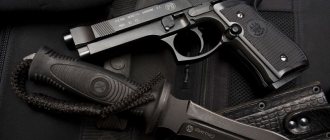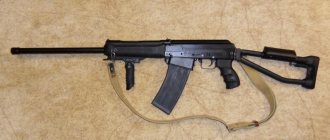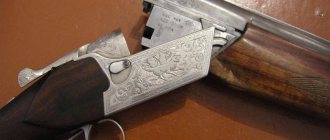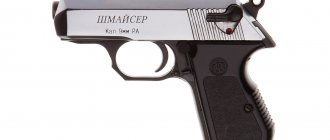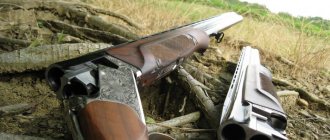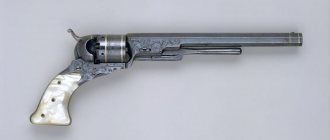The AKS-74U assault rifle is a folding shortened version of the famous Kalash, developed in the USSR in the late 1970s - early 1980s. The need for automatic short weapons arose during the Great Patriotic War: drivers of armored vehicles, pilots, paratroopers and gun crews needed to constantly have a reliable and trouble-free machine gun with them. The weapon was made on the basis of the standard AK-74, which used 5.45 mm cartridges. The first prototypes were handed over to units of the Ministry of Internal Affairs and demonstrated excellent performance in confined spaces. After the collapse of the USSR, short assault rifles began to be actively used in security structures; they are still used in the Ministry of Internal Affairs, where they are often affectionately called “short guns” or “Ksyukhas.”
Performance characteristics of the AKS-74U
In cross-section, it is an almost complete copy of its “big brother” AK-74.
The performance characteristics of the assault rifle in some positions do not correspond to the real state of affairs, although theoretically they are correct:
- The target firing range for group targets is stated to be up to 800 m, and for single targets up to 400 m;
- Combat rate of fire - 100 rounds per minute in bursts and 40 rounds per minute in single shots;
- Caliber 5.45x39 mm;
- The length of the machine gun with the butt unfolded is 735 mm;
- Barrel – 210 mm;
- The weight of the weapon without ammunition is 2.71 kg;
- The magazine capacity is designed for 30 rounds.
There are criteria for normal accuracy for the AKS-74U: four bullet holes must be in a circle with a diameter of 15 cm, and shooting is carried out at a distance of 100 meters in a prone position. At the same time, you need to understand that the purpose of a short automatic weapon is to fight at minimum distances, and in reality it is not always possible to take a prone position for shooting.
Acquaintance
The Kalashnikov assault rifle is an individual small weapon with the help of which enemy personnel are destroyed. AKs are also used to disable enemy fire weapons. In addition, you can eliminate the enemy hand-to-hand, using a machine gun equipped with a bayonet. It is possible to install universal night rifle sights on weapons. The ammunition used is an ordinary cartridge containing a steel core, and variants for which tracer bullets are provided. With full ammunition and without a bayonet, the machine gun weighs no more than 3.6 kg. Within one minute, up to 600 shots can be fired from the weapon.
The main parts of the weapon and its design
AKS-74U is easy to disassemble, and its components are reliable and durable.
Main parts of AKS-74U:
- Barrel with receiver;
- Sights;
- Folding stock;
- Pistol grip with a checkered design;
- Receiver cover;
- Flame arrestor;
- Trigger mechanism;
- Gate;
- Bolt frame with piston;
- Gas tube with receiver lining;
- Handguard;
- Return mechanism;
- Shop;
- Belt.
Standard sights for the AKS-74U consist of a rear sight and a front sight. For night shooting there is a special device: a folding rear sight with a wide slot and a large front sight with luminous dots. The rear sight does not separate during operation; during daytime shooting, it is simply moved downwards and fixed in this position.
How is burst shooting carried out?
The trigger is released from cocking thanks to a spring-loaded self-timer. Using this trigger element, the trigger is prevented from being pulled if the barrel channel of the machine gun is not closed or the bolt is not locked. The self-timer is equipped with:
- A sear with which the trigger is cocked.
- A special lever that rotates the self-timer by a protrusion in the bolt frame when it is in the forward position.
- Spring. It is located on the same axis as the self-timer. The long end of the spring crosses the receiver and is inserted into the annular groove on the axles, where the self-timer and trigger are located.
Operating principles of automation
Sometimes optical sights are installed on short machine guns, but this is not effective.
The work of the automatic “shortening” is based on the use of the energy of powder gases removed from the barrel bore. Parts and mechanisms function in a similar way to early Kalashnikov assault rifles, and the safety of the system has been tested for decades. Automatic actions when fired:
- Powder gases push the bullet out;
- The remaining gas is directed into the chamber and puts pressure on the wall of the piston, which is thrown along with the shutter to the rear position;
- The bore is opened by the bolt, the spent cartridge case is removed from the chamber and thrown out;
- The return spring is compressed under the action of the bolt frame, cocking the hammer;
- The return mechanism sends the bolt frame to the forward position, while a new cartridge is inserted and the barrel is locked;
- The self-timer sear is released from cocking due to the movement of the bolt frame;
- The trigger is cocked and the machine gun is ready for the next shot.
All modifications of the assault rifles lock the barrel by turning the bolt to the right around its axis.
Shooting from the AKS-74U is carried out with 5.45 mm cartridges with various types of bullets. They are intended to defeat enemy personnel located openly or behind minor obstacles. Typically these are cartridges with a steel shell covered with tombac. The core is made of steel, between it and the shell there is a lead jacket. Simple cartridges are not painted. Sometimes bullets with increased penetration and armor-piercing are used.
Shooting is carried out with tracer bullets; such cartridges are externally distinguished by the green color of the head part. These bullets are used to adjust fire and target designation; they can hit enemy personnel. There are armor-piercing tracer cartridges, but for short-barreled weapons their use is an unaffordable luxury. In any case, the most effective fire is carried out in short bursts of 3-5 shots.
There are several modifications of this machine:
- AKS-74UB is a silent version for special forces, often equipped with cartridges with a bullet of reduced muzzle velocity. The machine is distinguished by replacing the nozzle on the muzzle of the barrel with a special thread for attaching a muffler. The weapon has the ability to install an under-barrel grenade launcher BS-1M, turning into the Canary rifle-grenade launcher complex;
- AKS-74UN2 - night version, has a rail for attaching a sight for shooting in the dark.
Subsequently, modified versions of the AKS-74U were made; they had a dovetail-type side rail for attaching sights of different models.
Recently, design engineers of the Central Research Institute TOCHMASH developed a model of a submachine gun based on the AKS-74U, which has the same accuracy, but with a shorter firing range. This option is much lighter and has the ability to install a collimator rifle sight. In the future, it is planned to re-equip the Ministry of Internal Affairs, but since the AKS-74U has already been produced in excess, they continue to be used. Only special forces are armed with the new light submachine guns.
Kalashnikov AK/AKS assault rifle
| serial Kalashnikov AK assault rifle produced after 1951, with a milled receiver |
In the summer of 1943, at a meeting of the People's Commissariat of Defense of the USSR, based on the results of studying the captured German MKb 42(H) assault rifle and the American M1 carbine, it was decided that it was necessary to urgently develop its own set of weapons for an intermediate cartridge, which would provide the infantry with the ability to effectively fire at ranges of about 400 meters (beyond the capabilities of submachine guns).
7.62x39 mm cartridge
The development of the new complex began with the creation of a new cartridge, and already in November 1943, drawings and specifications of the new 7.62x39 mm cartridge, developed by designers Semin and Elizarov, were sent to all organizations involved in the development of small arms.
The development of weapons for the new cartridge began in several directions - an assault rifle, a self-loading carbine and a carbine with manual reloading.
Sudaev AS-44 assault rifle
In mid-1944, the testing commission selected for further development an assault rifle designed by Sudaev, which received the AS-44 index. Based on the results of its refinement, a decision was made to produce a small series and conduct military tests, which took place in the spring and summer of 1945 both in a group of Soviet troops in Germany and in a number of units on the territory of the USSR. The overall test experience was positive, but the military made a firm demand to reduce the weight of the machine gun.
experimental Kalashnikov assault rifle AK-46, incomplete disassembly
As a result, it was decided to conduct another round of tests, in which the designer of the Scientific Testing Range of Small Arms and Mortar Weapons (NIPSMVO) in the town of Shchurovo, M.T., also joined. Kalashnikov. In November 1946, Kalashnikov’s project, among some others, was approved for the production of prototypes, and Kalashnikov himself was sent to Kovrov Plant No. 2 for the production of prototype assault rifles.
| first experimental Kalashnikov assault rifle AK-46 |
Bulkin assault rifle
The first Kalashnikov assault rifle, known as the AK-46, had an automatic mechanism with a short-stroke gas piston located above the barrel and a rotating bolt similar to the M1 Garand rifle. The machine also had a split-receiver design, and a separate safety and fire mode selector on the left side of the weapon.
In December 1946, the Kalashnikov AK-46 assault rifle was presented for testing, where its main competitors were the Bulkin AB-46 assault rifle and the Dementiev AD assault rifle.
This was followed by a second round of testing, after which the AK-46 was declared unsuitable for further development by the commission. Dementiev assault rifle
Despite this decision, Kalashnikov (with the support of a number of members of the commission consisting of NIPSMVO officers with whom he served at the training ground since 1943) achieved a review of the decision and received approval for further development of his assault rifle. Returning to the city of Kovrov, Kalashnikov decided to radically rework his design, in which he was actively assisted by the experienced designer of the Kovrov plant, Zaitsev.
experimental Kalashnikov assault rifle of 1947, incomplete disassembly
As a result, for the next round of tests, a new assault rifle was actually created, which had the most minimal similarity with the AK-46, but received significant similarities with one of the main competitors - the Bulkin assault rifle (this includes a bolt frame with a rigidly attached gas piston, the layout of the receiver and its cover, the placement of the recoil spring with the guide, and the use of the protrusion on the recoil spring guide to lock the receiver cover). In general, all the key design solutions of the new machine gun were borrowed from other systems - for example, the trigger mechanism was borrowed with minimal improvements from the Czech Holek self-loading rifle, the safety lever, which was also a dust-proof cover for the bolt handle window, was “seen” from the Remington self-loading rifle 8 Browning design, “hanging” the bolt group inside the receiver with minimal friction areas and large gaps - in the Sudaev assault rifle. It should be especially noted here that all intellectual property at that time in the USSR was considered common, i.e. belonged not to one inventor, but to the entire people (or state), and accordingly could be used for the benefit of the people and the state by anyone. At the same time, the use of the sum of already proven and successful solutions in itself does not guarantee the success of the resulting model - this requires significant engineering and design work, which was done by Kalashnikov and Zaitsev in the shortest possible time.
| experimental Kalashnikov assault rifle 1947 first model |
As a result, three assault rifles were released for the next round of testing, conducted in December 1946 - January 1947 - slightly improved samples of Dementiev and Bulkin, as well as an actually new Kalashnikov assault rifle.
According to the test results, not a single sample fully satisfied the tactical and technical requirements (TTT). The Kalashnikov assault rifle, being the most reliable of all three, showed insufficient firing accuracy, and the only assault rifle that fully met the requirements for accuracy - the TKB-415 of the Bulkin system - had problems with the reliability and survivability of a number of parts.
| experimental Kalashnikov assault rifle 1947 second model |
At a meeting of the testing commission based on the results of the next stage of the competition, in the end, it was decided to recommend the Kalashnikov AK-47 assault rifle for military testing as the most reliable, and bringing it to the TTT requirements for accuracy of fire was postponed indefinitely.
It was decided to establish production of new Kalashnikov assault rifles at a plant in Izhevsk, where Kalashnikov was sent from Kovrov at the end of 1947. The first batches of new machine guns were assembled in Izhevsk in mid-1948.
| serial Kalashnikov AK assault rifle produced in 1949-51 with a stamped receiver |
At the end of 1949, based on the results of military tests, the new assault rifle was adopted by the Soviet Army in two versions under the designations “7.62mm Kalashnikov assault rifle AK” and “7.62mm Kalashnikov assault rifle with folding stock AKS” (for arming airborne troops), also known like AK-47 and AKS-47.
Serial production of new assault rifles began in Izhevsk with great problems. The main problem was the receiver, which was assembled from a stamped steel body and a massive milled liner in the front using rivets. Imperfect technology led to distortions in the shape and size of the receiver and other problems, which, in turn, caused a large percentage of defects. After analyzing the problems, the plant designers made a seemingly paradoxical decision - the transition to the “outdated” technology of milling the receiver from a solid forging instead of stamping and riveting will be economically justified due to a sharp reduction in the number of defects and returns of machine guns from military acceptance. The new receiver was developed in the department of the chief designer of the Izhevsk plant, and since 1951, AK and AKS assault rifles began to be produced with a milled receiver. At the same time, during production, numerous improvements were made to the design and production technology of the machines.
| serial Kalashnikov AK assault rifle produced after 1951 with a milled receiver |
AK automatics operate by removing powder gases through a side hole in the wall of the barrel bore. A gas piston with a rod is rigidly connected to the bolt frame. After the bolt frame moves away to the required distance under the influence of gas pressure, the exhaust gases escape into the atmosphere through holes in the gas tube. The barrel bore is locked by turning the bolt, while the two lugs of the bolt fit into the corresponding grooves of the receiver. The shutter is rotated by bevelling the bolt frame. The bolt frame is the leading element of the automation: it sets the direction of movement of the moving parts, absorbs most shock loads, and a return spring is placed in the longitudinal channel of the bolt frame (by analogy with submachine guns, it is sometimes not entirely correctly called “return-combat”).
The reloading handle is located on the right and is integral with the bolt frame.
| AK | AKS | |
| Caliber, mm | 7.62x39 | |
| Length, mm - butt unfolded - butt folded | 870 —— | 870 645 |
| Barrel length, mm | 415 | |
| Weight, kg | 4.07 | 4.25 |
| Store, count. cartridges | 30 | |
| Initial bullet speed, m/s | 715 | |
| Effective firing range, m | 500 | |
| Rate of fire, rds/min | 600 | |
When the bolt is unlocked by the bolt frame moving backwards, the cartridge case in the chamber is pre-displaced (“disturbed”). This helps relieve pressure in the chamber and prevents the case from rupturing during subsequent removal, even if the chamber is very dirty. The ejection of the spent cartridge case to the right through the receiver window is ensured by a spring-loaded ejector mounted on the bolt and a rigid receiver reflector. The “hung” position of the moving parts in the receiver with relatively large gaps ensured reliable operation of the system even with heavy contamination.
The impact mechanism is a hammer type with a trigger rotating on an axis and a U-shaped mainspring made of double twisted wire. The trigger mechanism allows for continuous and single fire. A single rotary part performs the functions of a fire mode switch (translator) and a double-action safety lever: in the safety position, it locks the trigger, the sear of single and continuous fire and prevents the rear movement of the bolt frame, partially blocking the longitudinal groove between the receiver and its cover. In this case, the bolt can be pulled back to check the chamber, but its travel is not enough to chamber the next cartridge.
All parts of the automation and trigger mechanism are compactly assembled in the receiver, thus playing the role of both the bolt box and the body of the trigger mechanism.
The first batches of AK-47 had, in accordance with the instructions, a stamped receiver with a forged barrel insert. However, the available technology did not allow the required rigidity of the box to be achieved at that time, and in mass production cold stamping was replaced by milling the box from a solid forging, which caused an increase in the weight of the weapon.
The rear stop of the recoil spring guide rod fits into the groove of the receiver and serves as a latch for the stamped receiver cover.
The AK assault rifle is fed from box-shaped steel magazines (later supplemented with light alloy magazines) of a sector shape with a staggered arrangement of 30 rounds.
The machine gun has a traditional sector sight with an aiming block located in the middle part of the weapon and a front sight located at the muzzle of the barrel, on a triangular base. The front sight is adjustable in height, covered on the sides with “post wings”, the sight is notched up to 800 m.
The Kalashnikov AKS assault rifle butt is folded.
For the convenience of holding the weapon, there are a pistol grip, a forend and a barrel lining (connected to a gas tube), made of wood.
The AK-47 was produced with a permanent wooden or folding forward-down metal (for the AKS-47) butt. In the socket of the AK-47 butt there was a pencil case with accessories for caring for the weapon.
During the production process, wooden parts made from birch blanks were gradually replaced: the stock was made of plywood board, the receiver was made of laminated veneer, and the pistol grip was made of plastic. A small Kalashnikov design group, together with technologists from the Izhevsk plant, somewhat reduced the weight of the machine gun through the introduction of new steel grades.
The ramrod was attached under the barrel and held in the fore-end channel due to its own elasticity.
Attached to the machine gun was a straight flat bayonet with a blade length of 200 mm and a width of 22 mm (on prototypes - a cleaver bayonet of the SVT-40 rifle).
| Kalashnikov AKS assault rifle |
The advantages of the AK assault rifle include high reliability even in the most difficult operating conditions, low maintenance, ease of use and maintenance, low cost in mass production. Deep thought, careful fine-tuning, comparative simplicity and peculiar elegance of the design with the widespread use of the principle of multifunctionality of parts determined the high reliability of the weapon in any conditions. This was greatly facilitated by the careful selection of materials - in particular, weapons-grade steel for the manufacture of the barrel and the most critical parts of the weapon. The survivability of a machine gun barrel is 15-18 thousand shots. The well-thought-out and refined shape of the machine gun made it compact, convenient to shoot and carry. Equally important is the ease of disassembling the machine and maintaining it.
| serial Kalashnikov AK assault rifle produced after 1951, equipped with a PBS-1 silencer |
A Kalashnikov AK assault rifle equipped with an NSP2 night vision device
. However, the AK, with all its advantages, also has a number of disadvantages - the safety translator, inconvenient to use, as well as the shape and size of the butt, especially cause a lot of well-deserved criticism. Rather rough sights with a short sighting line also do not contribute to shooting accuracy, especially with single shots.
Separately, it should be noted that one of the myths associated with the AK states that Kalashnikov “copied” the AK from the German MP-43 assault rifle, also known as the Stg 44, also indicating that, according to some sources, Schmeiser worked in Izhevsk from 1947 to 1950 .
Indeed, at first glance, the external layout of the AK and MP-43 is similar, as is the concept of an automatic weapon chambered for an intermediate cartridge. However, the similar outlines of the barrel, front sight and gas tube are due to the use of a similar gas engine, invented long before Schmeisser and Kalashnikov. Disassembling an AK and an MP-43 is fundamentally different: on an AK, the receiver cover is removed, on an MP-43, the trigger box is folded down on a pin along with the fire control handle. The barrel locking device is also different (rotary bolt on the AK versus bolt misalignment on the MP-43) and trigger mechanisms. It is likely that Kalashnikov knew about the MP-43, but it is obvious that when creating his machine gun he was more guided by other known models and systems of small arms. The main merit of Kalashnikov (or rather, of his entire team involved in the development and debugging of the machine gun) is precisely the optimal arrangement of already known and proven solutions into a single model that meets the requirements. Kalashnikov assault rifle modernized AKM with an installed under-barrel 40-mm grenade launcher GP-25
In the second half of the 1950s, the Kalashnikov assault rifle AK was modernized and in 1959 the new “7.62-mm Kalashnikov assault rifle modernized AKM” was adopted by the Soviet army. The production of Kalashnikov AK assault rifles in the USSR was discontinued.
AKs and subsequently AKMs were widely supplied to countries and regimes friendly to the USSR, both in the form of finished weapons and in the form of production licenses along with all the necessary documentation and technical assistance. 7.62 mm assault rifles were produced in Albania, Bulgaria, Hungary, East Germany, Egypt, Iraq, China, Romania, North Korea, Finland, and were supplied to even more countries. As a matter of fact, such a widespread distribution of Kalashnikov assault rifles in the world (as a rule, the number of AK-type assault rifles produced worldwide is estimated at about 90 million units) is primarily determined by the policy of the USSR, which generously distributed assault rifles and its production technologies to everyone who declared their readiness to follow the socialist path. ways or at least fight against world imperialism and colonialism. As a result of such generosity in the past, Russia subsequently lost a significant part of the assault rifle market, since only the lazy in the countries of the former socialist bloc did not produce one or another version of the Kalashnikov assault rifle. There is no need to talk about any violation of patent rights here, since even without taking into account the unoriginality of the design, its age exceeds all maximum periods of patent protection, and the patent for the “Kalashnikov assault rifle” received in 1997 (world patent WO9905467 dated February 4, 1999) actually protects only individual solutions embodied in the AK-74M series assault rifles, but not the earlier AK and AKM.
Features of the weapon, its advantages and disadvantages
The short barrel of the machine gun does not affect shooting accuracy up to 50 meters, but at 100 meters or more it is not easy to hit the target without a stop.
The differences between the machine gun and the standard AK-74 are immediately obvious:
- The barrel is 2 times smaller than that of a regular Kalashnikov, which led to high mobility and the ability to fight in cramped conditions in narrow rooms;
- The gas piston rod is shortened;
- A specially designed muzzle has been developed, which is both a flame arrester and serves as an expansion chamber;
- The fire rate slower has been removed;
- The rear sight is installed for shooting at distances of 200 and 400 m at single and group targets. Real combat from this machine gun can be carried out against single targets at distances of up to 100 meters, against group targets - at no more than 200 m;
- The receiver cover in the front part is hinged;
- A trigger rotation limiter is installed.
All other mechanisms of the AKS-74U completely copy the design of the AK-74 assault rifle. The short modification has a number of advantages:
- High mobility;
- Possibility of concealed wearing under clothing;
- The penetrating ability of the bullet at short distances is not inferior to the AK-74;
- Susceptibility to endless tuning. For example, installing a silent under-barrel grenade launcher allows you to clear obstacles and rubble, and a silencer turns the machine gun into a compact and silent weapon. The flash hider is easily removed and replaced with a modern muzzle brake;
- Possibility of installing pistol and additional handles.
Over the years of service, a number of weapon shortcomings have emerged:
- Heavy weight of the machine;
- Low sighting range, making installation of an optical sight pointless;
- Despite the high lethality of the bullet, the 5.45 mm caliber does not have an effective stopping effect;
- The machine quickly overheats when firing.
The overheating problem can be partially solved by replacing the standard AKS handguard with a ventilated one, but the short barrel will still continue to get very hot.
Features of the machine
Differences from
- trunk shortened by 2 times,
- shortened gas piston rod,
- a special muzzle is installed, serving as an expansion chamber and flame arrester,
- the receiver cover is hinged to the receiver in its front part,
- installation of a reversible rear sight at 350 and 500 meters,
- there is no rate of fire retarder,
- The rifling stroke length was reduced from 200 to 160 mm (for better stabilization of the bullet in flight with a short barrel).
- The front sight in the front sight is attached on top of the gas chamber (on the AK-74 the front sight post is a separate part and is located towards the muzzle). The width of the front sight is 1.6 mm (for the AK-74 it is 2 mm).
- Due to the shorter forend, it is impossible to install GP-25/GP-30 under-barrel grenade launchers.
- there is no possibility of attaching a bayonet.
From the point of view of all mechanisms, the AKS-74U is completely similar to the AK-74, with the exception of the trigger rotation limiter installed instead of the rate of fire retarder.
Advantages
- high mobility and the ability to be carried concealed;
- high penetrating power of the bullet (compared to the vast majority of submachine guns, including those designed for personal self-defense);
- high reliability, easy to clean;
- high range for weapons of this type. The initial velocity of the bullet (735 m/s versus 400-450 for samples under 9x19 “Parabellum”) is higher than that of most pistol ammunition, which reduces the bullet’s flight time to the target (and the amount of lead corrections for target movement). The better ballistic coefficient (aerodynamic indicator) of a small-diameter pointed bullet gives less drop in the bullet's trajectory.
- Unification of ammunition and magazines with the main model in service (AK-74), simplifying logistics (there is no need to supply drivers/tankers/radar operators with a different range of ammunition and magazines. Relevant only for military use
- Unification of a number of components with the AK-74/AK-74S (trigger mechanism, magazines, folding frame stock) reducing the cost of production and repair.
Flaws
- rather low accuracy of automatic fire due to a decrease in the initial velocity of the bullet;
- low target firing range compared to a full-size machine gun;
- low stopping effect of the bullet due to the use of the 5.45x39 mm cartridge in combination with the relatively low initial velocity of the bullet;
- tendency to quickly overheat when firing in bursts for a long time; 6-8 magazines fired in automatic mode usually lead to overheating of the barrel, decreased accuracy, “spitting” and often irreversible damage to the receiver (the problem is partially solved by replacing the forend with a ventilated one, such as RIS).
- For use in police tasks, the penetration of light high-velocity bullets of 5.45 mm caliber is excessive compared to pistol ammunition and is more prone to ricochets. There is a higher risk of injury to bystanders when used in crowded areas.
- For concealed carry, the bolt cocking handle protruding to the right and the butt folding to the left side increase the transverse dimensions of the weapon.
- When used with PBS and subsonic cartridges, the kinetic energy of the bullet is lower than that of samples chambered for the 9x39 cartridge (VSS/AS/9A-91). P
Partial and complete disassembly of the machine during maintenance
After each shooting, any firearm needs thorough cleaning.
The procedure for partial disassembly of the AKS-74U is carried out to clean, lubricate and inspect the general condition of the machine’s mechanisms. This operation is performed in a strictly defined order:
- The equipped magazine is separated;
- The bolt is jerked to make sure that there is no cartridge in the barrel;
- The flame arrester is removed;
- The receiver cover opens;
- The return mechanism and bolt frame are separated;
- The frame and shutter are separated;
- The gas tube is disconnected from the receiver lining.
This completes the process of incomplete disassembly. It is recommended to completely disassemble the AKS-74U mechanisms only during repairs or when they are heavily soiled. Complete disassembly of the machine:
- The magazine, bolt, return and firing mechanism are disassembled;
- The forend is separated.
The machine is assembled in the reverse order. After each shooting, the machine gun must be cleaned using gun lubricant and a solution for cleaning barrels from carbon deposits. Before long-term storage, AKS-74U is covered with a special liquid solution and wrapped in inhibited and waxed paper.
What is proposed to replace “shortening”?
In the mid-1990s, it was proposed to replace the Ksyukha with new AK-105.
In 1994, a new AK-105 assault rifle was created, intended to replace the AKS-74U. This model is capable of more effective fire at long distances due to the increased barrel length. The AK-105 is 94 mm longer, but its ballistic characteristics have increased. The heating of the barrel decreased, the butt and fore-end began to be made of black glass-filled polyamide. Firing devices, thrust rings, gas piston, swivel and some other metal parts are made by precision casting. A special coating is used to protect against corrosion. The AK 105 series sighting bar has a range of up to 500 m, which complies with the NATO standard.
New short machines are now in use:
- Private security;
- FSSP RF;
- FSUE "Security" of the Ministry of Internal Affairs of the Russian Federation.
The Russian army did not purchase AK-105 for its needs. Most employees of the Russian Ministry of Internal Affairs are armed with AKS-74U, and the ministry does not consider it advisable to carry out large-scale rearmament.
“Ksyukha” is still the most popular short machine gun of law enforcement agencies in Russia and the CIS countries. Over the past decades, weapons have repeatedly proven their effectiveness in urban environments. In the future, the prospect of re-equipping the Ministry of Internal Affairs employees with submachine guns created on the basis of the AKS-74U is being considered.

